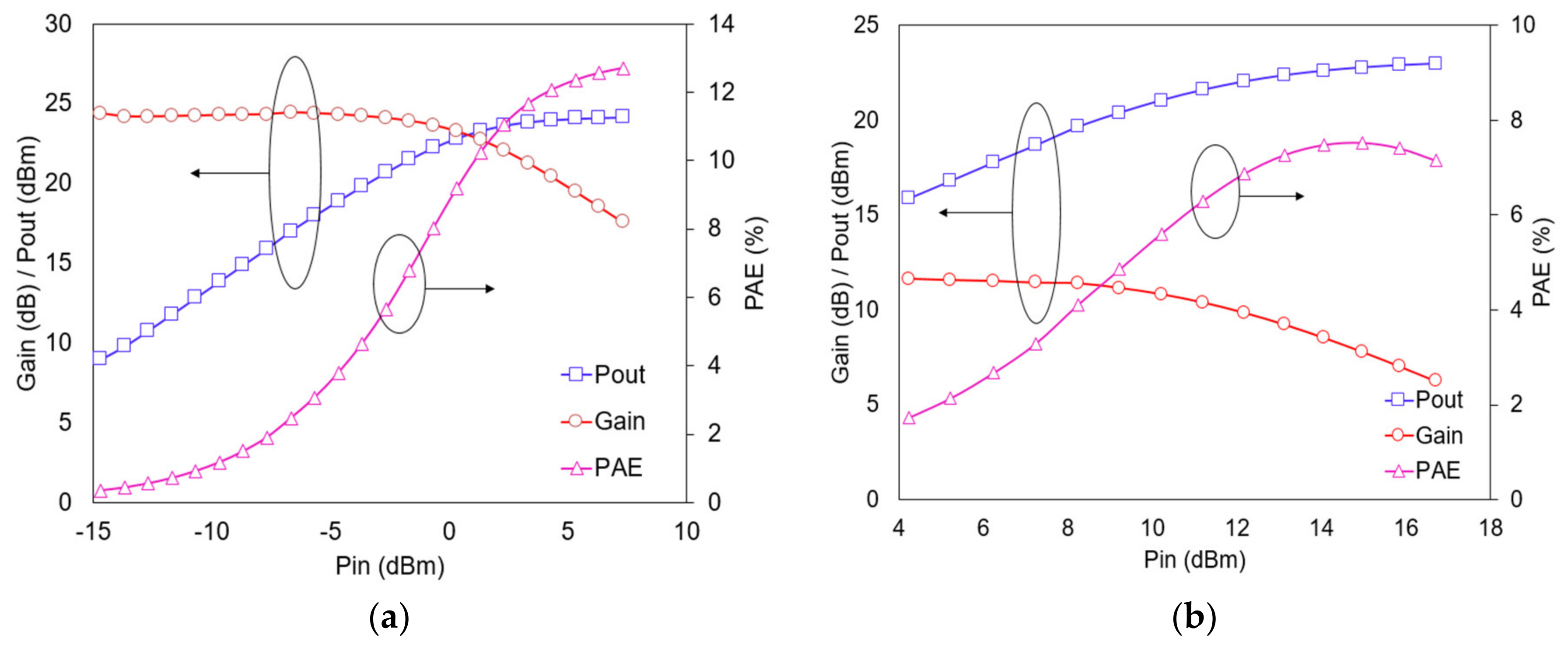Broadband Millimeter-Wave Power Amplifier Using Modified 2D Distributed Power Combining
Abstract
:1. Introduction
2. Circuit Design
3. Implementation and Measured Results
3.1. Implementation
3.2. Measured Results
4. Conclusions
Funding
Acknowledgments
Conflicts of Interest
References
- ETSI. NR; User Equipment (UE) Radio Transmission and Reception; Part 2: Range 2 Standalone (Release 15). 3GPP TS 38.101-2; ETSI: Sophia Antipolis, France, 2020; pp. 35–39. [Google Scholar]
- Zhong, M.; Yang, Y.; Yao, H.; Fu, X.; Dobre, O.A.; Postolache, O. 5G and IoT: Towards a new era of communications and measurements. IEEE Instrum. Meas. Mag. 2019, 22, 18–26. [Google Scholar] [CrossRef]
- Kim, Y.; Kwon, Y. Analysis and design of millimetre-wave power amplifier using stacked-FET structure. IEEE Trans. Microw. Theory Tech. 2015, 63, 691–702. [Google Scholar] [CrossRef]
- Fei, W.; Yu, H.; Liang, Y.; Lim, W.M. A 54 to 62.8 GHz PA with 95.2mW/mm2 output power density by 4 x 4 distributed in-phase power combining in 65nm CMOS. In Proceedings of the IEEE MTT-S International Microwave Symposium, Tampa, FL, USA, 1–6 June 2014; pp. 1–4. [Google Scholar]
- Fei, W.; Yu, H.; Shang, Y.; Yeo, K.S. A 2-D distributed power combining by metamaterial-based zero phase shifter for 60-GHz power amplifier in 65-nm CMOS. IEEE Trans. Microw. Theory Tech. 2012, 61, 505–516. [Google Scholar] [CrossRef]
- Wu, C.-T.M.; Itoh, T. Dual-fed distributed amplifier-based CRLH-leaky wave antenna for gain-enhanced power combining. In Proceedings of the IEEE MTT-S International Microwave Workshop Series on Innovative Wireless Power Transmission: Technologies, Systems, and Applications, Kyoto, Japan, 10–11 May 2012; pp. 87–90. [Google Scholar]
- Wu, C.-T.M.; Dong, Y.; Sun, J.S.; Itoh, T. Ring-resonator-inspired power recycling scheme for gain-enhanced distributed amplifier-based CRLH-transmission line leaky wave antennas. IEEE Trans. Microw. Theory Tech. 2012, 60, 1027–1037. [Google Scholar] [CrossRef]
- Kim, S.; Lee, J. Resonance frequency and bandwidth of the negative/positive nth mode of a composite right-/left-handed transmission line. J. Electromagn. Eng. Sci. 2018, 1, 1–6. [Google Scholar] [CrossRef] [Green Version]
- Ng-Molina, F.Y.; Martin-Guerrero, T.M.; Camacho-Penalosa, C. Power and gain considerations in distributed amplifiers based on composite right/lefthanded transmission lines. IET Microw. Antennas Propag. 2010, 4, 1000–1006. [Google Scholar] [CrossRef]
- Vigilante, M.; Reynaert, P. A wideband class-AB power amplifier with 29–57-GHz AM–PM compensation in 0.9-V 28-nm bulk CMOS. IEEE J. Solid State Circuits 2018, 53, 1288–1301. [Google Scholar] [CrossRef]
- Wu, P.; Huang, T.; Wang, H. An 18–71 GHz multi-band and high gain GaAs MMIC medium power amplifier for millimeter-wave applications. In Proceedings of the IEEE MTT-S International Microwave Symposium, Philadelphia, PA, USA, 8–13 June 2003; pp. 863–866. [Google Scholar]
- Chuang, M.; Wu, P.; Lei, M.; Wang, H.; Wang, Y.; Wu, C.S. A miniature 15–50-GHz medium power amplifier. In Proceedings of the IEEE Radio Frequency Integrated Circuits (RFIC) Symposium, San Francisco, CA, USA, 10–13 June 2006; pp. 471–474. [Google Scholar]
- El-Aassar, O.; Rebeiz, G.M. Compact pMOS stacked-SOI distributed power amplifier with over 100-GHz bandwidth and up to 22-dBm saturated output power. IEEE J. Solid State Circuits Lett. 2019, 2, 9–12. [Google Scholar] [CrossRef]












| UE Power Class | UE Application | Operating Band | Minimum Peak EIRP 1 (dBm) |
|---|---|---|---|
| 1 | Fixed wireless access (FWA) | n257 (26.5~29.5 GHz) | 40 |
| n258 (24.25~27.5 GHz) | 40 | ||
| n260 (37~40 GHz) | 38 | ||
| n261 (27.5~28.35 GHz) | 40 | ||
| 2 | Vehicle | n257 (26.5~29.5 GHz) | 29 |
| n258 (24.25~27.5 GHz) | 29 | ||
| n261 (27.5~28.35 GHz) | 29 | ||
| 3 | Handheld | n257 (26.5~29.5 GHz) | 22.4 |
| n258 (24.25~27.5 GHz) | 22.4 | ||
| n260 (37~40 GHz) | 20.6 | ||
| n261 (27.5~28.35 GHz) | 22.4 | ||
| 4 | High power non-handheld | n257 (26.5~29.5 GHz) | 34 |
| n258 (24.25~27.5 GHz) | 34 | ||
| n260 (37~40 GHz) | 31 | ||
| n261 (27.5~28.35 GHz) | 34 |
| Reference | Frequency (GHz) | Technology | Psat (dBm) | P1dB (dBm) | Peak PAE (%) | Power Bandwidth Product 1 | Gain (dB) | Topology |
|---|---|---|---|---|---|---|---|---|
| [10] | 29–57 | 28 nm CMOS | 15.1–16.6 | 10.9–13.4 | 24.2 | 0.91 | 20 | Transformer-based combining |
| [11] | 19–57 | 0.15 μm GaAs pHEMT | 16–19 | NA | NA | 1.51 | 15–27 | DA + cascade amp |
| [12] | 15–50 | 0.15 μm GaAs pHEMT | 18–22 | 15–19 | 19 | 2.21 | 15 | Cascaded DA |
| [13] | 20–60 | 45 nm SOI PMOS | 19–21.7 | 17.5–19 | 18.4 | 3.18 | 16 | Stacked DA |
| [4] | 53–62.8 | 65 nm CMOS | 16–17.2 | 15.5–16.6 | 11.3 | 0.39 | 14.5–17.5 | SEDFDC |
| [5] | 44–60 | 65 nm CMOS | 11 2 | 9.7 2 | 7.1 2 | 0.20 | 8.3 2 | SEDFDC |
| This work | 26–56 | 0.15 μm GaAs pHEMT | 20.3–24.2 | 19.9–22.8 | 12.7 | 3.21 | 12.9–21.8 | Modified SEDFDC |
© 2020 by the author. Licensee MDPI, Basel, Switzerland. This article is an open access article distributed under the terms and conditions of the Creative Commons Attribution (CC BY) license (http://creativecommons.org/licenses/by/4.0/).
Share and Cite
Kim, J. Broadband Millimeter-Wave Power Amplifier Using Modified 2D Distributed Power Combining. Electronics 2020, 9, 899. https://doi.org/10.3390/electronics9060899
Kim J. Broadband Millimeter-Wave Power Amplifier Using Modified 2D Distributed Power Combining. Electronics. 2020; 9(6):899. https://doi.org/10.3390/electronics9060899
Chicago/Turabian StyleKim, Jihoon. 2020. "Broadband Millimeter-Wave Power Amplifier Using Modified 2D Distributed Power Combining" Electronics 9, no. 6: 899. https://doi.org/10.3390/electronics9060899
APA StyleKim, J. (2020). Broadband Millimeter-Wave Power Amplifier Using Modified 2D Distributed Power Combining. Electronics, 9(6), 899. https://doi.org/10.3390/electronics9060899





